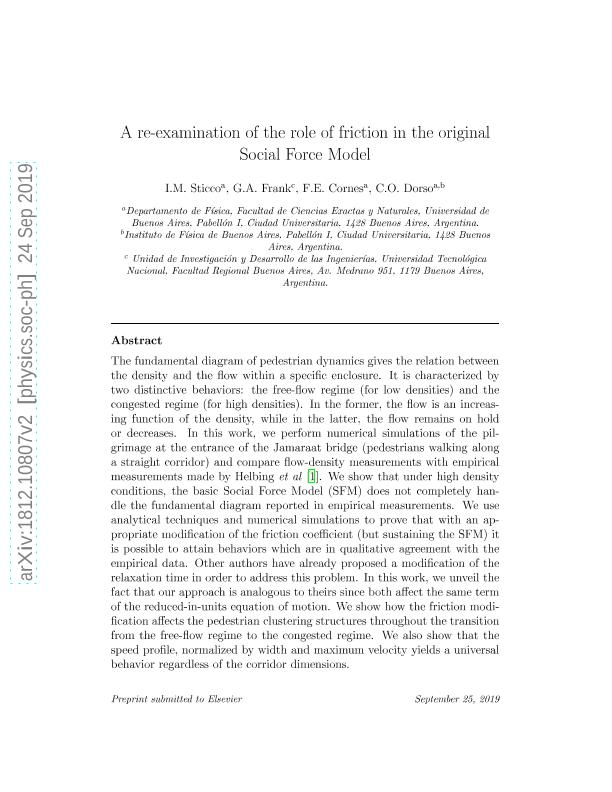Artículo
A re-examination of the role of friction in the original Social Force Model
Sticco, Ignacio Mariano ; Frank, Guillermo Alberto
; Frank, Guillermo Alberto ; Cornes, Fernando Ezequiel
; Cornes, Fernando Ezequiel ; Dorso, Claudio Oscar
; Dorso, Claudio Oscar
 ; Frank, Guillermo Alberto
; Frank, Guillermo Alberto ; Cornes, Fernando Ezequiel
; Cornes, Fernando Ezequiel ; Dorso, Claudio Oscar
; Dorso, Claudio Oscar
Fecha de publicación:
01/2020
Editorial:
Elsevier Science
Revista:
Safety Science
ISSN:
0925-7535
Idioma:
Inglés
Tipo de recurso:
Artículo publicado
Clasificación temática:
Resumen
The fundamental diagram of pedestrian dynamics gives the relation between the density and the flow within a specific enclosure. It is characterized by two distinctive behaviors: the free-flow regime (for low densities) and the congested regime (for high densities). In the former, the flow is an increasing function of the density, while in the latter, the flow remains on hold or decreases. In this work, we perform numerical simulations of the pilgrimage at the entrance of the Jamaraat bridge (pedestrians walking along a straight corridor) and compare flow-density measurements with empirical measurements made by Helbing et al. (2007). We show that under high density conditions, the basic Social Force Model (SFM) does not completely handle the fundamental diagram reported in empirical measurements. We use analytical techniques and numerical simulations to prove that with an appropriate modification of the friction coefficient (but sustaining the SFM) it is possible to attain behaviors which are in qualitative agreement with the empirical data. Other authors have already proposed a modification of the relaxation time in order to address this problem. In this work, we unveil the fact that our approach is analogous to theirs since both affect the same term of the reduced-in-units equation of motion. We show how the friction modification affects the pedestrian clustering structures throughout the transition from the free-flow regime to the congested regime. We also show that the speed profile, normalized by width and maximum velocity yields a universal behavior regardless of the corridor dimensions.
Palabras clave:
JAMARAAT PILGRIMAGE
,
PEDESTRIAN DYNAMICS
,
SOCIAL FORCE MODEL
Archivos asociados
Licencia
Identificadores
Colecciones
Articulos(IFIBA)
Articulos de INST.DE FISICA DE BUENOS AIRES
Articulos de INST.DE FISICA DE BUENOS AIRES
Articulos(SEDE CENTRAL)
Articulos de SEDE CENTRAL
Articulos de SEDE CENTRAL
Citación
Sticco, Ignacio Mariano; Frank, Guillermo Alberto; Cornes, Fernando Ezequiel; Dorso, Claudio Oscar; A re-examination of the role of friction in the original Social Force Model; Elsevier Science; Safety Science; 121; 1-2020; 42-53
Compartir
Altmétricas



